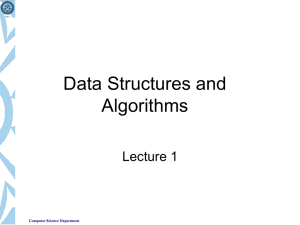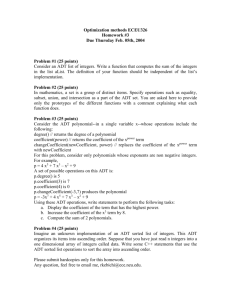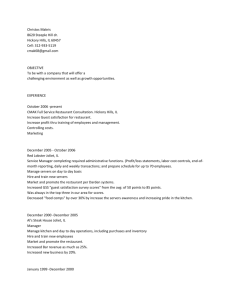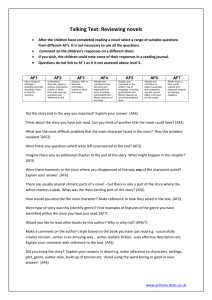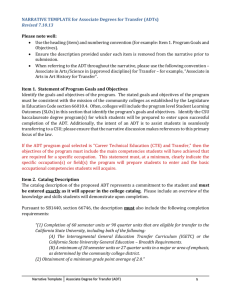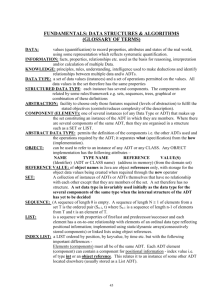Using the Functional Independent Skills Handbook (FISH)
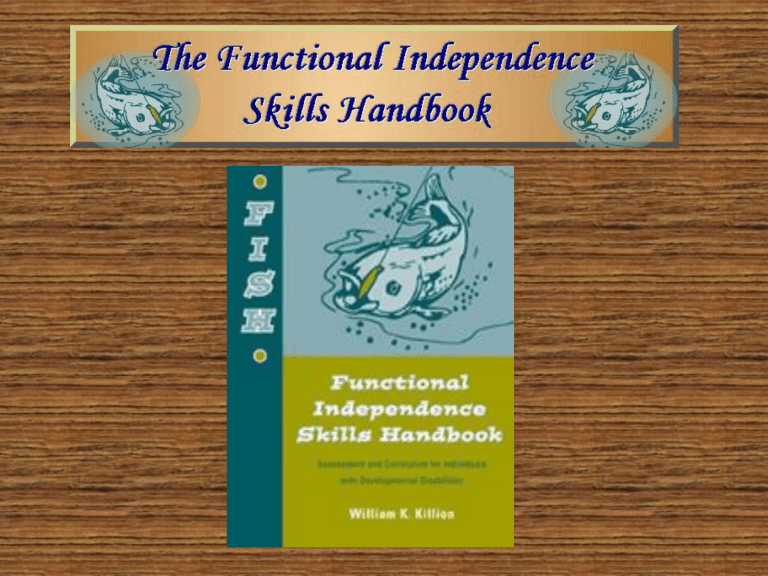
Types of assessment
Domains of Learning- F.I.S.H.
Name Code Description
• Adaptive Behavior
ADT (152) Activities of daily living.
• Affective Skills
• Cognitive Skills
AFF (11) Emotional and behavioral issues.
COG (75) Reading, writing and arithmetic.
• Sensorimotor Skills
SEN (35) Basic movement skills.
• Socialization
SOC (44) Personal interactions with others.
• Speech & Language
S&L (24) Communication needs.
• Vocational Skills
VOC (80) Prevocational / vocational skills.
The Baseline Assessment
Can perform on own or with a single total task prompt
Physically or reasonably impossible considering the client’s condition.
Needs at least some assistance or guidance to accomplish
Note: A task can not be both Independent and Non-applicable
Five Steps to Getting the FISH Information
1.) Find a person to act as the Respondent, which needs to be someone who knows the client well. This could be a caregiver, parent or close family member. In some cases the client themselves could serve this role.
2.) In a setting as free of distractions as reasonable, explain to the
Respondent the meaning of “Independent”, “Non-applicable” and
“Dependent”. Briefly show and explain the test form to the Respondent.
The assessment can be given over a number of sessions if needed.
3.) Using the test form go over each item, with the Respondent, for skills known be “Independent” or “Non-Applicable”, making check marks as appropriate. If doubt seems present for an item, review the actual FISH objective with the Respondent. Leave the “Dependent” items unchecked.
4.) Using the formula provided in the FISH manual, plot the score on the graph for each of the 7 domains.
5.) Observe and/or interact with the client either before or after meeting with the Respondent to verify some of the skills that were reported.
ADT 86- Look in mirror
F.I.S.H. Assessment
Domain
Code
ADT 1 *
ADT 2 *
ADT 3 *
ADT 4 *
ADT 5 *
ADT 6 *
ADT 7 *
ADT 8
ADT 9 *
ADT 10 *
ADT 11 *
ADT 12 *
Adaptive Behavior
Program
Can "attend" to object or task
Responds to nearby activities
Will hold objects in hand
Can point to or identify an object.
Can discriminate between two items
Identifying associated objects
Identify objects for use in eating.
Use water fountain.
Drinking from a cup or glass.
Eating finger foods.
Eating with a spoon.
Eating with a fork.
Independent Not Independent
Baseline Applicable Follow Up
ADT
AFF
COG
SEN
SOC
S&L
VOC
Independent
Baseline
5%
45%
17%
57%
25%
21%
0%
F.I.S.H. Baseline Graph Example
F unctional I ndependence S kills H andbook Scales
John K.- ( Baseline- 7/01/2005) (Follow Up)
100
90
80
70
60
50
40
30
20
10
0
ADT AFF COG SEN SOC S&L VOC
Domain
Independent
Baseline
Independent
Follow Up
Assistive devices can still allow for independence
Hidden Agenda
Behavioral Objective
Measurable and Observable
Task Analysis
=
Selecting lesson plans
1.) Solicit the opinion of the client, the family and/or the caregiver as to what un-mastered skills would be the most desired.
2.) With respect to the information from step one, select items that are close to an “Independent” item. Use Appendix
A to determine if the prerequisite skills are present.
Remember, prerequisite skills are only a guideline, not a requirement.
3.) If difficulties are encountered with a lesson, briefly attempt an already mastered skill/ lesson to give the student more confidence in the learning environment.
4.) Modify lesson plans as may be needed to focus on client interests. Materials and techniques can be changed in any functional ways. The objective, however, should remain the same .
If an asterisk is next to a program code, it means that the task can lead to other skills in the program.
ADT 6*
Identifying associated objects
ADT 6- Sample Program
Task: Identifying associated objects.
Prerequisites: ADT 1, ADT 2 and ADT 4
Concept: The concept of association is the beginning of memory skills. The identification of items that “go together” also begins the process of multiple step task performance. In this exercise real objects that are used in the student’s environment are the most effective teaching tools. Although lesson ADT 5,
Can discriminate between two items, is not a prerequisite for this skill, the lesson may go easier if
ADT 5 is tried first.
Behavioral Objective: When presented with 3 items common to the environment, 2 that are related in function and 1 that is not, the student will be able to indicate by pointing or eye gaze which of the 2 objects
“go together” to an 80% accuracy over 20 trials.
Materials: Items common to the environment such as a toothbrush & toothpaste, a comb & brush, a spoon & fork, a pencil & paper, a cup & bowl, etc.
Task Analysis:
1.) Verify that the student can identify each of the items that have been selected as materials. (See prerequisite ADT 4.)
2.) Place 3 objects, 2 related (e.g.- comb & brush) and 1 not related (e.g.cup) in front of the student and ask “Show me which two go together?” If some positive response is noted go to step 7, otherwise continue on to the next step.
3.) Arrange each grouping of materials that “go together”.
Describe and explain how they are used and why each item is related to the other.
4.) Present to the student groupings of 2 items, some that do go together and some that do not. Seek and encourage yes/no answers as to whether or not the items shown “go together”.
Use physical guidance as needed to encourage correct response.
ADT 6- Sample Program (continued)
5.) Continue on with step 4, using only gestural prompting.
6.) Continue with step 4, using no prompting.
7.) Provide continuous social reinforcement for each successful identification of items that go together until an 80% or greater level of accuracy is noted for 20 trials.
8.) Systematically reduce reinforcement down to only 1 time for 20 trials and continue until program criteria are met (80% for 20 trials).
Functional Independence Skills ABA Data Sheet
Client:
Task Code Task
Date:
(Objective Completion Sheet)
+/+/+/+/Initials
Comments
Initial Legend:
The Follow Up Assessments
F.I.S.H. Assessment
Domain
Code
ADT 1 *
ADT 2 *
ADT 3 *
ADT 4 *
ADT 5 *
ADT 6 *
ADT 7 *
ADT 8
ADT 9 *
ADT 10 *
ADT 11 *
ADT 12 *
Adaptive Behavior
Program
Can "attend" to object or task
Responds to nearby activities
Will hold objects in hand
Can point to or identify an object.
Can discriminate between two items
Identifying associated objects
Identify objects for use in eating.
Use water fountain.
Drinking from a cup or glass.
Eating finger foods.
Eating with a spoon.
Eating with a fork.
Independent Not Independent
Baseline Applicable Follow Up
Independent
ADT
AFF
COG
SEN
SOC
S&L
VOC
Follow Up
11%
82%
39%
66%
30%
67%
0%
F.I.S.H. Follow Up Graph Example
F unctional I ndependence S kills H andbook Scales
John K.- ( Baseline- 7/01/2005) (Follow Up- 9/01/2005 )
100
90
80
70
60
50
40
30
20
10
0
Independent
Baseline
Independent
Follow Up
ADT AFF COG SEN SOC S&L VOC
Domain
Appendix A is designed to provide the teacher with a listing of the suggested prerequisites for each of the F.I.S.H. lessons.
Domain
Code
ADT 48 *
ADT 49
Adaptive Behavior Skills
Prerequisites
ADT 1, ADT3, SEN 12, SEN 13
ADT1, ADT3, ADT 41-ADT 48, COG 11, SEN 12,
SEN 13
Appendix B serves to explain the future value of a current lesson. Note that all of these lessons have a beside them, noting that they are prerequisite skills.
Code
SEN 6 *
SEN 7 *
SEN 8 *
Potential Future Lessons
SEN 33
SEN 9, SEN 33, SOC 34, VOC 14, VOC 15
ADT 57
100
Functional Independence Skills Handbook- Scales
B F Baseline 10/1/12 Follow Up- 1/31/15
80
60
40
20
0
ADT AFF COG SEN SOC
Domain
Independent Baseline Independent Follow Up
S&L VOC
100
Functional Independence Skills Handbook- Scales
G T Baseline 4/20/13 Follow Up- 2/28/15
80
60
40
20
0
ADT AFF COG SEN SOC
Domain
Independent Baseline Independent Follow Up
S&L VOC
100
Functional Independence Skills Handbook- Scales
O A Baseline- 11/6/14 Follow Up- 3/7/15
80
60
40
20
0
ADT AFF COG SEN SOC
Domain
Independent Baseline
Independent Follow Up
S&L VOC
